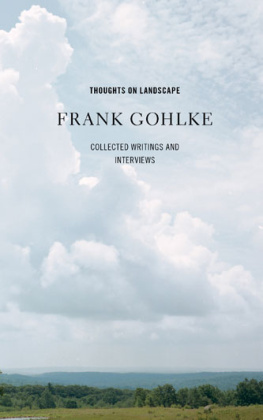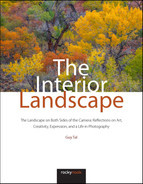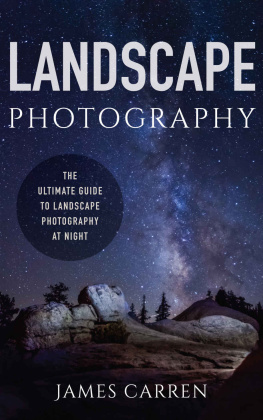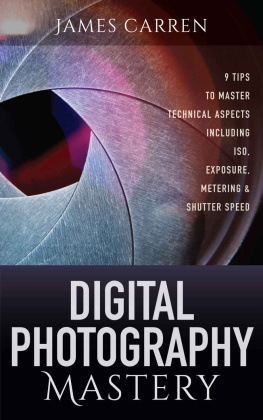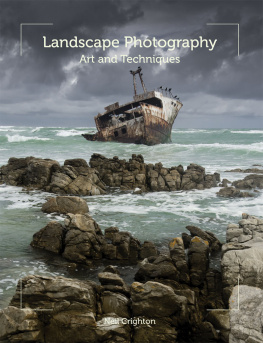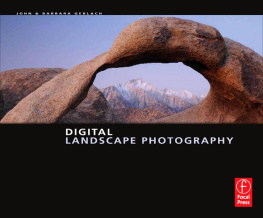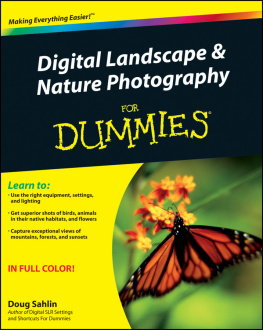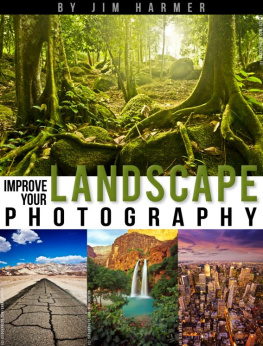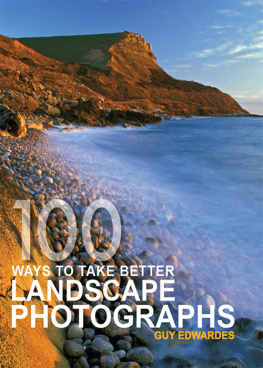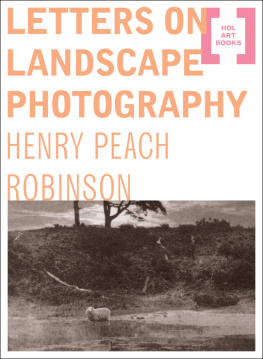Other than a brief period of interest in high school and subsequent casual snapshooting, I didnt have anything to do with photography until my third year of graduate work in English literature (196667), when my antipathy to the written word finally undermined my pretensions to scholarship. I bought a camera, and I began to look at photographs seriously for the first time. I was fortunate enough to have a good art library at my disposal at Yale, and doubly fortunate to be able to meet, show my first pictures to and receive encouragement from Walker Evans who was then teaching in the Yale Art School. After about six months of working on my own, I began studying with Paul Caponigro during weekends at his home in Connecticut, and this continued for eight months. From Caponigro I learned the control of tonal values, which has remained an important aspect of my work, and I absorbed some of his complete seriousness and dedication to making pictures.
I spent the next three years refining my technical skills and attempting to resolve the two contradictions in my work caused by the still powerful mental and emotional presence of Caponigro. It was during this time that I had my first shows at Middlebury and Bennington Colleges and had my first photographs purchased for the George Eastman House Collection. In 1971, I moved from rural Vermont to Minneapolis, the most important external event in the development of my photography. No longer distracted by the beauty of the New England landscape, I was now free to deal with my surroundings on terms which I myself had made. I discovered that my affinities with the human artifacts around me, the new and the old, and my deepest curiosities centered upon the ways in which the vast spaces of the American midland were humanized by these artifactswhich themselves began to take on qualities of the natural elements they were intended to temper or subdue.
Simultaneously with this renewed interest in subject matter, I began coming to terms with various kinds of formal difficulties in my work. I was gravitating towards the square format as a means of simplifying and clarifying my vision. I wanted to be able to locate an object centrally in the frame without worrying about filling in the picture to the edges. I wanted to be able to call the viewers attention to particular objects without resorting to conventional pictorial means which would require the subordination on an absolute scale of one part of the picture to another. I wanted an image which was static rather than dynamic, which asserted the equal importance of everything within the frame, and which could be viewed in any order one chose. I wanted to develop an idiom which would cut against certain proclivities of mine which, when indulged excessively, led in very conventional directions, such as my affinity with the sculptural effects of light on textured objects. I wanted to be able to use those things which connect to whatever runs deepest in me without giving in to them, to call attention to them without distorting their relationship to the contexts in which they occur. I think the photographs I have made since coming to Minneapolis have come steadily closer to fulfilling all these criteria. My aim is to make photographs that are at the same time lyrical and intellectual, intensely personal yet rich in information, neither reticent nor effusive.
In the two years I have already been working on the grain elevator project, it has evolved from an almost exclusive concern with the structures themselves to a much more inclusive attempt to locate these objects within the landscape that has brought them forth. Although the purely sculptural aspect of grain elevators still affects me powerfully, it is the complex implications of the structures in relationship to the land that now interests me most. They are alternatively (and sometimes simultaneously) sacred monuments to fertility and abundance, natural facts like sky, mountains, land and water, desperate attempts to relieve monotony and provide points of reference in an almost featureless landscape, pivots for a complicated network of agricultural and economic activities, or simply the only place where anything is happening in a small farm town.
Now to the questions put to me by Allan Porter : After several attempts, I have still not been able to answer them to my own I satisfaction, and I am sending instead a quotation by Brassa which sets out so simply and eloquently what I take to be the basic issues involved in making documentary photographs, as well as touching many of the questions raised, that anything I might add would be redundant and superfluous:
If, as a photographer, I had to choose between life and art, I should always choose life first because, unlike painting, the thing that is magnificent about photography is that it can produce images that incite emotion based on subject matter alone. But can one forget that a photograph is also a problem, an area to be filled and, as such, it must contribute certain aesthetic factors? This is not to make a work of art but has a completely pragmatic aim: to rid the picture of all excess fat, to say with all clarity what one has to say, to hold and direct the eye with conviction. Except in cases where the emotion is produced entirely by the subject, no photograph can produce its full effect, to become a definitive and unchangeable picture, without respecting some elementary rules of art.
At opposite poles, there exist two kinds of photographers: some are conscious of the living thing but have no sense of form, others confuse the art of photography with artistic photography, and let the living thing escape them. It is as easy to fall into an aesthetic formalism as into the easy acceptance of the mere snapshot. For my part, I always seek a certain equilibrium between the living thing and form, and though I hesitate to use the word, I would say a classic equilibrium. I think also that only photographs in which the ephemeral in life takes on an immutable form merit being called photographic images.
I think that it is daily life which is the great event, the true reality. My greatest ambition is to do something new and striking using the banal and commonplace to show an aspect of daily life as if one were seeing it for the first time.
One personal note: of all the other arts, music is the most important to me. I go to music not only for spiritual sustenance and renewal, but for instruction as well. Im sure Ive learned as much about structurehow a piece of work fits togetherfrom the string quartets of Mozart and Beethoven as from photographs; I know there is a connection between what I hear and what I am able to see, but I have no idea how it operates. I mention this only because of the remarkable number of photographers I know personally or am aware of who share the same dual affinity. There is an important linkage there that should be explored, but I dont think anyone has an adequate language for it yet.
[] Only two?
[] Editor-in-Chief of Camera magazine.
[] Brassa, Camera magazine United States (1953).
Autobiographical statement in "Camera" 55, no. 5 (1976).
Ben Lifson has been a friend of mine for many years. I cant see that anything is gained by concealing or ignoring that fact, or by my attempting to maintain a tone of detachment I do not feel. If I can use my intimacy with this work, having witnessed its growth and its connections to the life of its maker, to clarify the shape and content of the world it describes, then I will have done what I hoped to do in this introduction.
Most of these photographs were made in cities, but seldom in their centers. Only in Tijuana do we encounter the crowded sidewalks and frenetic jumble of a commercial district; everywhere elsein Tucson and Atlanta, New York and Bostonwe keep to the parks and residential neighborhoods, back streets and quiet courtyards. This is primarily a landscape of leisure and domesticity, of places set aside for public display and private pleasure. It is peopled by families, friends and lovers, whose various modes of intimacy are described with an exactitude which does not conceal the questions behind it. It is a very mixed world.

